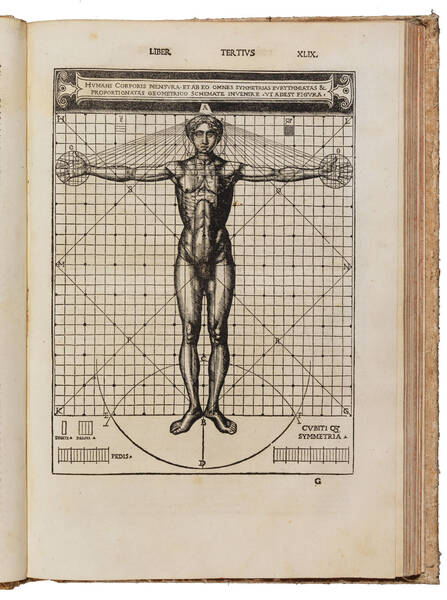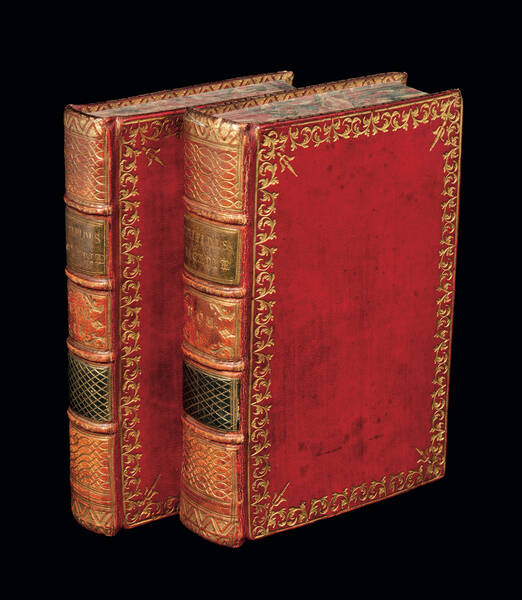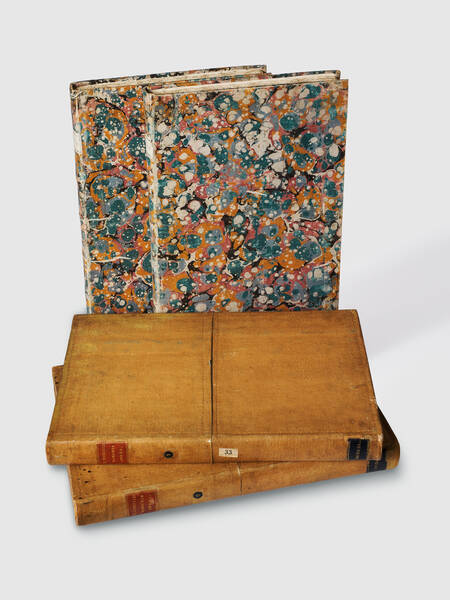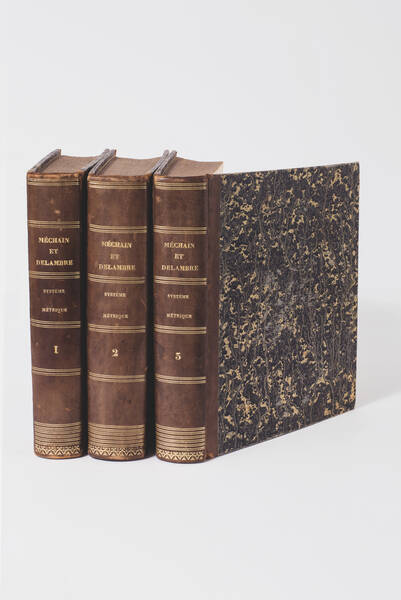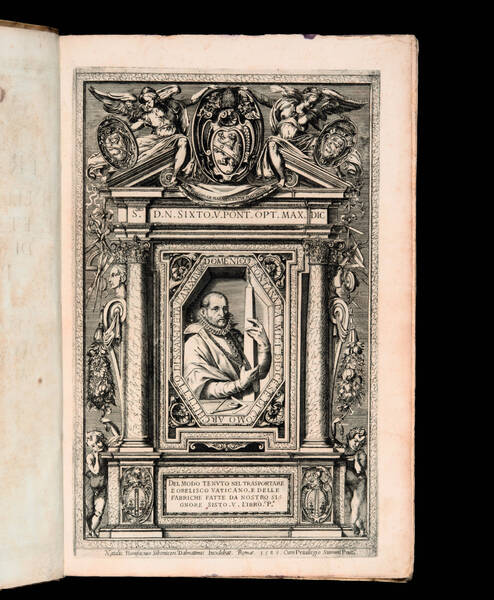GUALLA, Giacomo. Iacobi Gualle iureconsulti Papie sanctuarium.
Pavia, per magistrum Jacob de Burgofrancho., 1505 die X mensis NouembrisQuarto (207 x 152 mm.), 92, [6], [4] leaves (in our copy the index is bound at the end), Gothic types. 35 lines + headline. White-on-black wood-engraved and floriated initials, a few black-on-white wood-engraved initials. Four-piece historiated architectural border. Woodcut author portrait on title page and repeated inserted in a historiated and floriated border at the beginning of index, 67 woodcuts illustrations of saints (29 blocks, 38 repeats), woodcut printer's device; first page entirely illuminated by a contemporary artist. A few spots, several marginal annotation by a contemporary hand, overall a very fine copy in contemporary limp vellum with manuscript title on spine.
First edition of "the most important of the Pavian books with woodcuts" (Kristeller, "Books with Woodcuts Printed at Pavia", Bibliographica, I, 1895, pp. 347-372). Papie sanctuarium which provides information on saints and relics in the churches of Pavia is in effect a sort of Mirabilia Papiae, correspondent to that given in the numerous Mirabilia Romae editions for Rome. As former residence of Theodoric the Great and capital of the Lombard empire, Pavia's claims to ecclesiastical antiquity were strong, and constantly opposed to those of Milan. Gualla's text includes a bibliographic element, for there are lists of the writings of major saints, including Augustine and Severinus, with incipits of their work. “Jacobus Gualla's lives of the saints of Pavia a guide to the reliquaries in the churches of the city was printed after the author's death in early 1505. It was edited by G.F. Picius and printed for Paulus Morbius by Jacobus de Burgofrancho. It is illustrated with a woodcut portrait of the author, repeated twice, and sixty-seven small woodcuts from twenty-nine different wood blocks. The text is printed in black and is decorated with simple line and black-ground foliated initial letters of very fine quality and Burgofrancho's printer's device. This edition of Papie sanctuarium is described by Kristeller as ‘undeniably the most important of the Pavian books with woodcuts.' The woodcuts in Burgofrancho's Papie sanctuarium are well documented by Kristeller who writes: ‘In them the characteristics of the style of woodcut as practiced at Pavia and especially in the office of Jacobus de Burgofrancho are seen in full distinction.' The portrait of the author … is an excellent example of the Pavian style. It combines the influence of Milanese portrait painting with the thinly cut outline border design of the Ferrarese masters. The portrait is delicately cut with lines of varied thicknesses resulting in a figure of individual character. The folds of the cloak incorporate curved lines, with loop and angle cuts, highlighted with parallel lines of varied lengths cut in different directions. The border, cut in outline without shading, is distinguished by the thinness of the line and the clarity of the image. The use of roundels and curved-line design for flowers and the figures of the putti with musical instruments and the two satyrs at the base of each column are in the popular style of the Venetian design. The eyes of the figures in the roundels are quite large, with lids half closed and dark centers. The overall effect is a light, airy border of original character. This border first appeared in Laurentius Rubeis's of Francesco Negri's Pullata printed in Ferrara early in 1505. The same border style is repeated here in another finely cut frame, surrounding a small portrait of Saint Jerome found at the end of the text. Of the remaining twenty-nine woodcuts, most are portraits cut in outline and highlighted with shading and some cross-hatching. The portrait of Saint Jerome was originally used by Laurentius Rubeis in his famous edition of Vita epistole of Saint Jerome printed in 1497. Two other cuts, Saint Siro and the Statue of Regisole, appeared first in Burgofrancho's Statuta of Pavia, published in August 1505. They were copied, and in the case of the Regisole, the composition was reversed, and used in the November edition of Papie sanctuarium. A particularly well-conceived and well-executed portrait woodcut from this group of smaller cuts is the image of Saint Symphorosa and her Seven Sons. The composition is arranged with Saint Symphorosa standing at the center of the image with her arms outstretched, gathering her boys beneath her open cloak in order to protect them. All the figures are well defined, with individual facial characteristics and finely contoured costumes, and the cut is highlighted by the use of black space to define heavily shaded areas and thin parallel lines. Nine of the smaller cuts in the book are of equal distinction, and all of them exhibit one of more of the characteristics of the Pavian style.” (Daniel De Simone. A Heavenly Craft. The woodcut in early Printed Books. New York-Washington, 2004)
Edit 16 CNCE 21926; Mortimer 222; Adams G,1351; Sander 3288.
Other Books
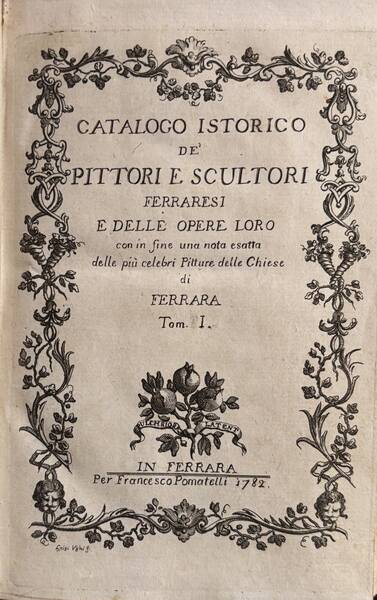
CITTADELLA, Cesare
Catalogo istorico de' pittori e scultori ferraresi e delle opere loro con in fine nota esatta delle più celebri pitture delle chiese di Ferrara.
€ 2.200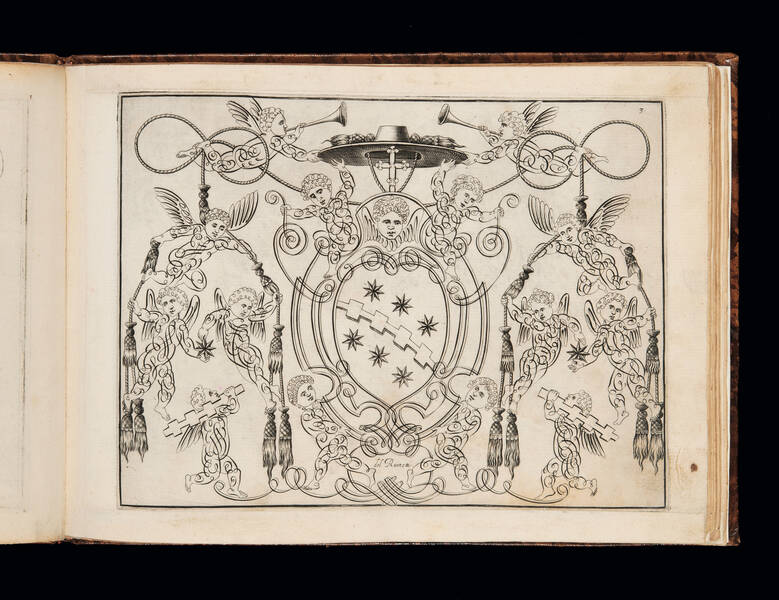
RUINETTI, Tomaso
Idea del buon scrittore, opera prima di Tomaso Ruinetti da Ravena a’beneficio de’desiderosi d’imitare le vere forme dello scrivere.
€ 8.000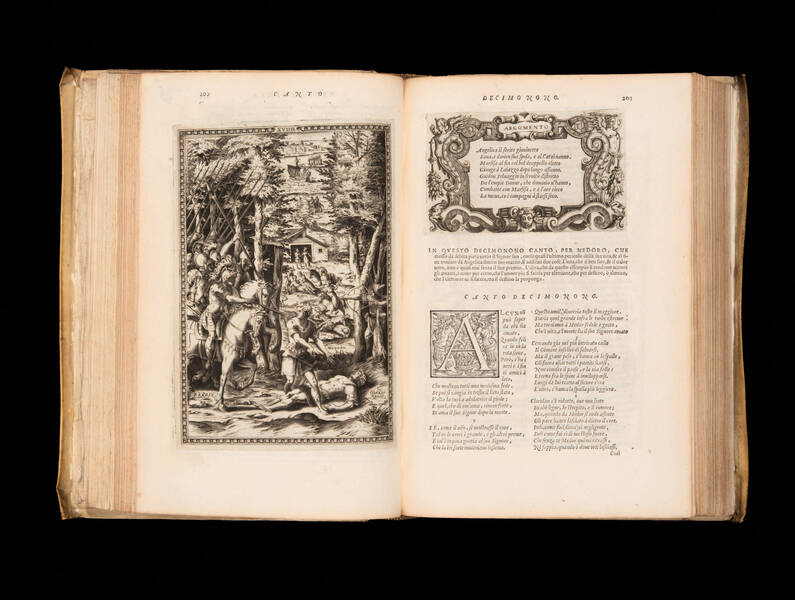
ARIOSTO, Ludovico
Orlando furioso di m. Lodouico Ariosto nuouamente adornato di figure di rame da Girolamo Porro padouano et di altre cose che saranno notate nella...
SOLD OUT
GALILEI, Galileo
Opere, divise in quattro tomi, in questa nuova edizione accresciute de molti cose inedite.
SOLD OUT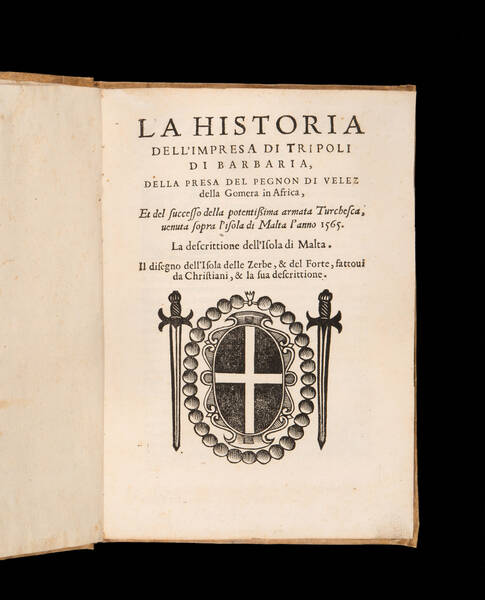
ULLOA, Alfonso de
La Historia dell'impresa di Tripoli di Barberia, della presa del Pegnon di Velez della Gomera in Africa, et del successo della potentissima armata...
€ 12.000![Trattato della natura de’ cibi et del bere [...] nel quale non solo tutte le virtù, & i vitij di quelli minutamente si palesano; ma anco i rimedij per correggere i loro difetti copiosamente s’insegnano. Trattato della natura de’ cibi et del bere [...] nel quale non solo tutte le virtù, & i vitij di quelli minutamente si palesano; ma anco i rimedij per correggere i loro difetti copiosamente s’insegnano.](https://www.medariquier.com/typo3temp/pics/d4e0248596.jpeg)
PISANELLI, Baldassarre
Trattato della natura de’ cibi et del bere [...] nel quale non solo tutte le virtù, & i vitij di quelli minutamente si palesano; ma anco i rimedij...
€ 9.500
PETRARCA, Francesco
Li Sonetti canzone e triumphi del Petrarcha con li soi commenti non senza grandissima euigilantia et summa diligentia correpti et in la loro primaria...
€ 9.000![Tragoediae septem cum commentariis. [Greek] Edited by Johannes Gregoropoulos Cretensis]. Tragoediae septem cum commentariis. [Greek] Edited by Johannes Gregoropoulos Cretensis].](https://www.medariquier.com/typo3temp/pics/a7f4ddada3.jpeg)
SOPHOCLES
Tragoediae septem cum commentariis. [Greek] Edited by Johannes Gregoropoulos Cretensis].
SOLD OUT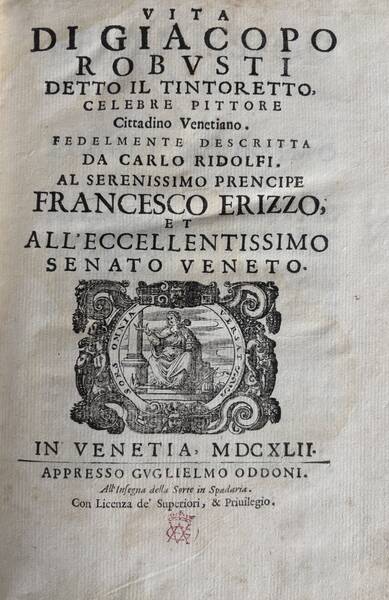
RIDOLFI, Carlo
Vita di Giacopo Robusti detto il Tintoretto, celebre pittore, cittadino venetiano.
€ 2.500MEDA RIQUIER rare books ltd.
4 Bury Street St James's
SW1Y 6AB London
Phone +44 (0) 7770457377
info@medariquier.com
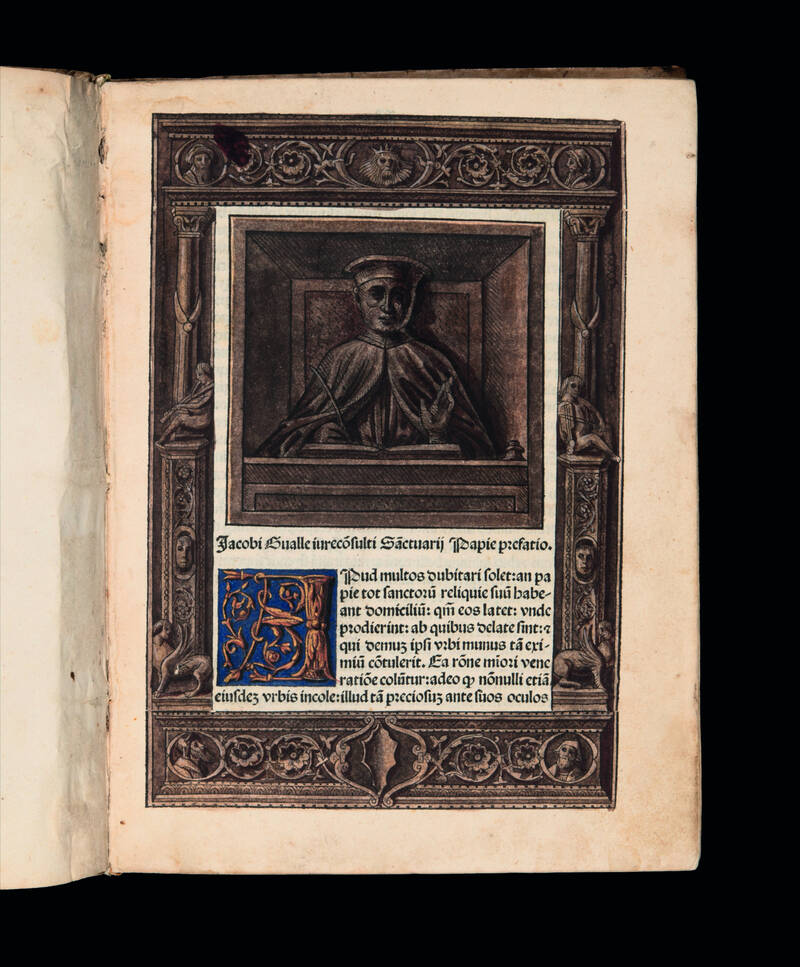
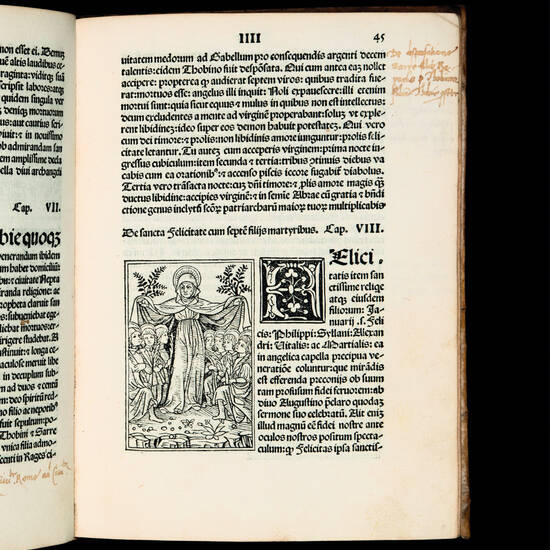
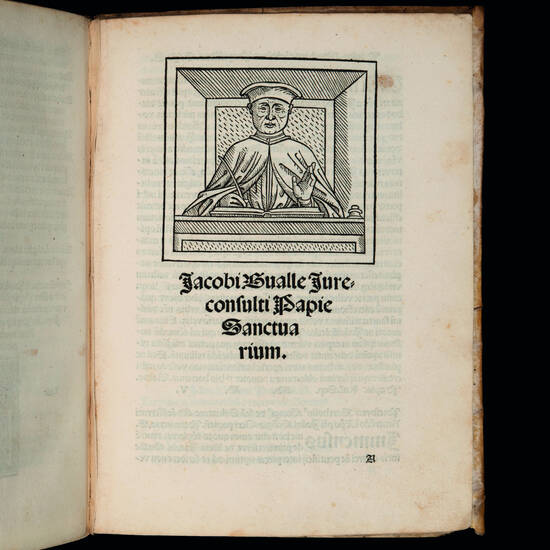
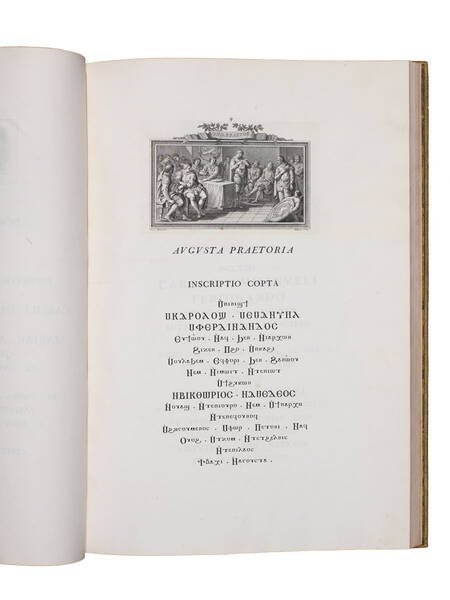
![Opera posthuma [Compendium grammatices linguae hebraeae]. Opera posthuma [Compendium grammatices linguae hebraeae].](https://www.medariquier.com/typo3temp/pics/9e46dbc214.jpg)
